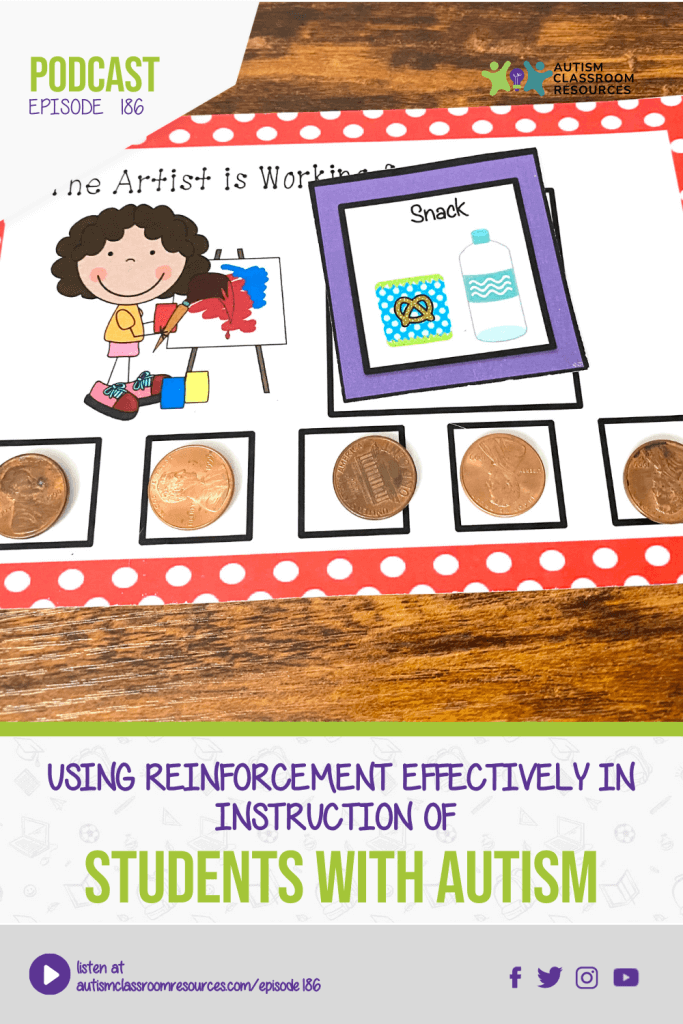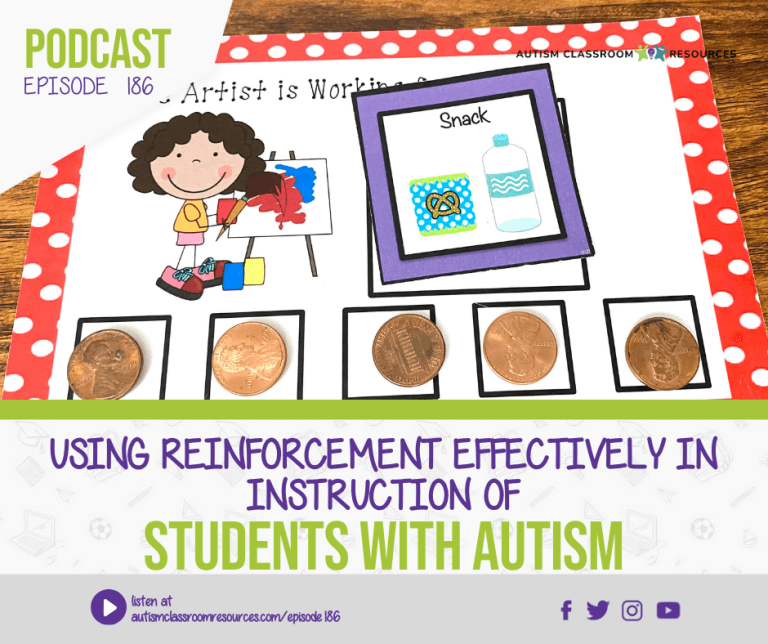Welcome to the Autism Classroom Resources Podcast, the podcast for special educators who are looking for personal and professional development.
Christine Reeve: I’m your host, Dr. Christine Reeve. For more than 20 years, I’ve worn lots of hats in special education but my real love is helping special educators like you. This podcast will give you tips and ways to implement research based practices in a practical way in your classroom, to make your job easier and more effective.
Welcome back to the Autism Classroom Resources podcast. I’m Chris Reeve, and I’m your host. And we are in the midst of bite sized episodes on the elements of instruction. These are elements broken down from simple instructional loops of each opportunity to answer and respond to a direction, a problem, or things like that. You can get an overview of all of the elements in Episode 180 at autismclassroomresources.com/episode180.
Today we’re going to talk about using reinforcement effectively in instruction. I mentioned in last week’s episode, it’s the reinforcement that does the teaching. And I’ve talked in the past about reinforcement quite a bit, actually, most recently in Episode 178.
So today, I’m going to focus just on why reinforcement is so important in our instruction, and some of the things that we need to make sure we attend to when we use it. So let’s get started.
So I mentioned in most previous posts and episodes that we have to define reinforcement by its impact on the behavior or the skill that it follows. Behavior analysts, just hang in there with me, I will get past this.
Reinforcement by its definition results in behaviors or skills that increase when that item or action follows them. If the skill or behavior doesn’t increase over time, what we thought was a reinforcer isn’t really working as a reinforcer. So with that definition in mind, let’s talk a little bit about reinforcement in instruction.
Often we use praise as a reinforcer with young learners, and it is reinforcing for them. They are more likely to get answers that result in the adult praising them, they’re more likely to give them in the future. But that isn’t a reinforcer for everyone. And for many of our learners with autism, it isn’t always understood, and it doesn’t always work as a reinforcer. So when we start instruction, we want to pair instruction and ourselves with things or activities that are reinforcing for them.
Second, when using reinforcement in instruction, we need to be very clear across the classroom team about what specific performance we are reinforcing. This is probably one of the biggest areas that I see people struggle with. So if we’re using a working for a board, where we’re earning pennies or buttons to get to a specific reinforcer, we need to make sure that we’re putting those tokens on in a systematic way.
If we’re just starting out teaching a skill, we would give a token every time they follow the direction or get the answer right. And it’s a token system is new to them, we probably want to start with just having them earn one token at first and then get to the reinforcer, because students aren’t going to be able to start understanding that a token is reinforcement, until we teach them that the token leads to reinforcement. Then over time, obviously, we want to fade out the reinforcement. And that’s where token board can be really helpful.
We can start requiring two right answers before they get to the reinforcer and then three. This helps them to see that they are still getting the right answer and see how many more they need to get correct before getting the reinforcing activity or item.
But what we want to be careful not to do is to give the reinforcer for simply getting to the end of the activity, unless persisting in the activity was the goal that you’re trying to increase.
So one of the biggest areas that I see people struggle with, especially using working for boards, is they use a working for board, they give the pennies or the buttons, or the tokens, whatever they are, and they work it out so that the reinforcement comes in a natural break in instruction, when maybe the student would get that break or that activity anyway.
And so consequently, earning that reinforcement really is not dependent on whether or not the student has given a correct answer. We sometimes fall into the trap of reinforcing completion instead of accuracy. So make sure that you know exactly what behavior or skill that you’re aiming to reinforce and want to See increase. If it’s correct responding, then we start by only giving tokens when they get the right answer. Otherwise, students can just wait until there’s a natural break and get the reinforcer regardless of whether or not they improved their performance.
So along that same line, we want to make sure that we’re differentiating our reinforcement for different skills. For instance, if a student is learning to count with one to one correspondence, we would reinforce every correct attempt at counting. And we would probably start out reinforcing prompted attempts at first, and then fade the prompts out. We fade the prompts by changing how much reinforcement we give to the prompted answers.
So if we used fewer prompts, or less intrusive prompts, if all I had to do was point instead of do hand over hand, then maybe he gets reinforced, and then later, when we fade the prompt out, completely, he gets it. Once they’re getting the right answer regularly, then we would start fading out the reinforcement for one to one correspondence. But if we started teaching them to combine sets of objects, we should go back to reinforcing, possibly with prompts, but at least every correct answer.
So let’s say we’re working on both skills at the same time, alternating counting out the sets, and then combining the sets. We might give a high five for counting the sets, since that skill has a longer history of accuracy. But we might reinforce every single correct response for combining the sets of objects. Even though the skills are related, we differentiate how we give reinforcement, so that we’re reinforcing the right thing and increasing the right skill, and they have less experience and less correct history with combining the set. So that reinforcement needs to be higher than the one the skill that they’re already closer to mastering.
Obviously, there is a ton more to say about reinforcement, and I can go on and on forever. But those are the three elements that I think are the most critical for using it in instruction.
Your action item this week is to evaluate how you’re using reinforcement in your instruction, and to look across the classroom and see if other staff are using it in the same way that you are. If you need reinforcement tools, I have free token working for boards in my store that are designed with themes for younger students.
But I also just added a token economy toolkit. It’s designed for classroom management. But there are also token boards that are appropriate for older students that focus on things like earning money or sports teams, those kinds of things. And you can find them at autismclassroomresources.com/tokeneconomy, and I’ll put them in the show notes as well. For the younger students, you can grab a set of free token boards in the show notes as well. And that will take you to the full set that’s in my TPT store.
Thanks so much for tuning into this episode. Next week, I will be back to talk all about progress monitoring and data collection. How do we know if a student is progressing in their learning if we don’t take data? But it’s not enough to just take it, we need to analyze it but it doesn’t have to kill you in order to get it done. And we’ll be talking all about that.
If you found this episode helpful, I would love it if you would share it with a friend or colleague, or hop over to Apple podcast site and leave a review of the podcast itself. I always love to hear from listeners with their thoughts about episodes as well so feel free to tag me on Instagram or drop into my DMs @autismclassroomresources. Have an amazing week.
Thanks so much for listening to today’s episode of the Autism Classroom Resources podcast. For even more support, you can access free materials, webinars and Video Tips inside my free resource library. Sign up at autismclassroomresources.com/free. That’s F-R-E-E or click the link in the show notes to join the free library today. I’ll catch you again next week.








